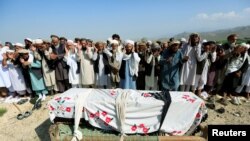The United States military Tuesday refuted as “one-sided” a new report that civilian casualties caused by American and coalition airstrikes in Afghanistan had spiked to record levels.
The report released Monday by the Costs of War project at Brown University attributed the increase to a 2017 decision by the Trump administration to relax the rules of engagement for airstrikes against the Taliban. It claimed the number of Afghan civilians killed in the strikes has since increased by 330%.
“We disagree with the one-sided analysis presented in Costs of War, which relies on disputed data and ignores civilian casualties caused by Taliban and ISIS attacks,” U.S. military spokesman Col. Sonny Leggett said, using an acronym for the Islamic State terror group.
“This includes ongoing Taliban use of car bombs, IEDs [improvised explosive devices], rockets and targeted killings to intimidate, harass and instill fear across Afghanistan,” he added in a written response shared with VOA via email.
Leggett drew attention to the latest quarterly report by the United Nations that acknowledged Afghan civilian casualties caused by U.S. airstrikes “all but ceased” since February 29, the date when Washington sealed a troop withdrawal agreement with the Taliban.
“That same report attributed more than 3,400 civilian casualties to 'anti-government elements,' including ISIS and the Taliban,” he noted.
The Costs of War project says the escalation in U.S. airstrikes was seemingly directed at increasing pressure on the Taliban to negotiate peace. In 2019 alone, airstrikes killed 700 civilians — more civilians than in any other year since the beginning of the war in 2001 and 2002, the report said.
However, the U.S. reduced the number of airstrikes after signing the landmark deal with the Taliban and began withdrawing troops from Afghanistan to wind down what is dubbed America’s longest war.
The Costs of War project also acknowledged that the pact led to a reduction in the airstrikes and the harm to Afghan civilians caused by those strikes.
The U.S.-Taliban agreement opened first-ever direct peace talks in September involving the insurgent group and representatives of the Afghan government. The slow-moving dialogue is being hosted by Qatar.
The Costs of War project cautioned that while international forces had pulled back on airstrikes, the U.S.-trained-and-equipped Afghan Air Force has increased combat missions against the Taliban, inflicting heavy casualties on civilians.
“The Afghan government is now negotiating with the Taliban. And as part of a broader offensive perhaps aimed at increasing Afghan government leverage in the talks, airstrikes by the Afghan Air Force [AAF] have increased. As a consequence, the AAF is harming more Afghan civilians than at any time in its history,” said Neta Crawford, co-director of the project.
Crawford noted the uptick in civilians killed by AAF airstrikes between July and September 2020 was particularly striking. It noted that in the first six months of this year, the AAF killed 86 Afghan civilians and injured 103 civilians.
“That rate of harm nearly doubled in the next three months. Between July and the end of September, the Afghan Air Force killed 70 civilians, and 90 civilians were injured,” Crawford said.
Critics such as Torek Farhadi, a former adviser to the Afghan government, say the work of the AAF is clumsy. He cited killings of civilians, including children, in recent AAF airstrikes that hit a mosque, a school and even a hospital in northern parts of the country.
“The truth is that these air raids by the Afghan Air Force are carried out blindly with low skill, and often the tips are given based on tribal rivalries,” he said.
While the U.S. may have passed an increased share of the role of conducting airstrikes to the AAF, the U.S. is to some extent responsible for the performance of the AAF, according to the Costs of War project.
“We take seriously our duty to train our Afghan counterparts on civilian casualty prevention measures, and we have observed an extraordinary amount of effort and care in their operations,” Leggett said, while defending the performance of the Afghan security forces.
Leggett again urged all sides of the conflict to “substantially” reduce violence to allow the Afghan peace process to take hold.










